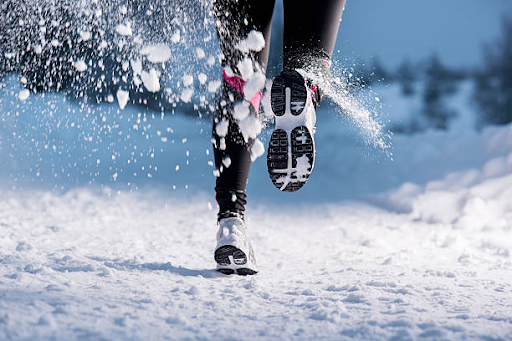Tips for Running in the Winter

Photo Source: Pexels.com
January 13, 2023
The winter leaves many runners with an interesting choice: head indoors and hit the treadmill, or tough the elements and stay on the roads. Which is the lesser of the two evils can be a contentious debate, but personally, there is no question. I am a treadmill hater.
That being said, running outdoors in the winter requires both a resolve and a careful approach. It is more dangerous than running in the summer, and more unpleasant the majority of the time.
In this article, I’ll be compiling advice that has helped me with my winter running, as well as observations I’ve made myself. Here are my tips for running in the winter.
1. Mind the ice
Ice. It’s what comes to mind most often when people consider the perils of winter running. It’s a serious threat to balance everywhere, but one that can be avoided.
Personally, I have never slipped and fallen on ice in my time running outdoors. Part of it has been skill, most of it has been luck. There are a couple of good strategies to avoid ice, and the first is being aware of when it is most common.
In New England’s winters, the weather can get complicated. It can get cold, then warm, then cold all over again in a short period of time. This, combined with rain, is the perfect mixture for ice. When the weather pattern threatens a flash freeze, it’s best to avoid running.
If you must run on a day when ice is more likely, there are a few things you can do to keep from falling. For one, try to get out there after the salt trucks have gone by. Or, as an alternative, try to run on trails that are less likely to accumulate water and ice.
On icy days, avoid going off on a brand-new route and stick with the familiar. Running on roads and paths you know will keep the surprises to a minimum.
Proper equipment is another way to stop slipping. Some shoes are specially designed to combat ice, with spikier treads that help to grip surfaces better.
Above all, watch your step – there’s nothing worse than being oblivious while running. Understand where you are and where water may pool to form ice. Be on the lookout, as black ice can sneak up quick.
2. Let someone know your route
Regardless of the season, this is good practice when running. Letting someone know where it is you’re headed is good for personal safety all the time. In the winter, however, it is especially important to have someone know where it is you’re going. If you are to slip and fall, get caught out in the dark, or simply get too cold, it’s good to have a safety net and someone looking out for you.
3. THE Trick for Wet Shoes
If there is one thing worse than wet shoes, it’s wet shoes in the winter. These can be tough to combat, too, as leaving them out in the sun to dry is no longer an option when the weather gets cold.
After returning home with wet shoes, perhaps from rain, sleet, or snow, try this: stuff paper towels or newspaper into your wet shoes. I like to loosen the laces to open up the shoe as well. The next day, this material will have soaked up most of the water and shoes will dry quicker. It’s a much better alternative to blow-drying your shoes dry. Pro-tip: don’t do it.
4. Layers
Being smart with your layers can make or break your winter running. Too little and you’ll be at risk of freezing out there, too many, and you’ll be uncomfortably stuffy on the run. General wisdom, supported by doctors, suggests to dress for weather that is about 15-20 degrees warmer than the weather you’ll be running in.
Running pants and leggings are a must. I only started using them this year, and they are fantastic. Not only do they conform to the legs, allowing for better movement, but they are great at keeping the muscles warm, which keeps the muscles healthy.
5. Care for the extremities
Wear a hat and gloves. These are the best items to insure comfort on a winter run. Cold ears and fingertips are unpleasant, and even become dangerous when it comes to frostbite. Gloves don’t have to be thick, either, just enough to cover up from the elements.
Also, an extra pair of socks on top of the ones you’re already wearing can help insulate the feet while running.
6. Keep an eye on the Sun
In the winter, sunset can come up quick. You might leave the house thinking you’ve got plenty of daylight left, but find yourself in the dark a few miles from home. Frequently, I check to see what the sunset time will be and plan my run around that. I find I can be out there for ten or fifteen minutes beyond the listed sunset time, but after that it gets dangerous.
7. Hydrate
The winter is a great time for sneaky dehydration. Unlike the summer, water doesn’t feel quite as necessary in the winter. But while you may not feel thirsty, your body still is. Make sure to stay on top of drinking water not only after a run, but leading up to the exercise as well.
8. Watch the heart rate
In the winter, the heart has to compensate for colder temperatures and more restricted blood flow. Therefore, the heart may work harder than it does in more moderate temperatures. If your heart rate climbs as the temperature drops, don’t be alarmed. This can happen, and is only a sign that your heart is adapting according to the changing conditions.
Still, that doesn’t mean it is healthy to exercise at excessively high heart rates. It is only to say that runs that felt easier in the fall might get more strenuous in the wintertime.

9. Pay attention to the wind
It’s a good idea to pay attention to the direction that the wind is blowing when heading out for an out-and-back run. Running with the wind at your back on the way out will feel great, and might even coax you to pick up the pace. Upon turning around, however, you will quickly realize that the way back can get tricky.
Running back into the wind is tough no matter what time of year it is, but becomes especially uncomfortable in the winter. This is because any sweat produced on the way out now gets cold in the wind coming at you. Fighting both the wind and your own freezing perspiration makes for a miserable trek back come.
10. Warm up indoors
Whether you have a treadmill, exercise bike, or just an empty space to start your warm-up in, it’s a good idea to warm up indoors before a run. This way, you aren’t starting your run cold. Try some exercises and stretches inside, then step outside and get right to running.
With less time spent outside, your muscles will stay warm straight from your warm-up into your run.
11. Run on softer ground
Oftentimes, the frozen ground and cold air can take a toll on the legs. Nagging pains tend to flare up in the winter months, with less bounce in each step.
As three-season Pentucket distance runner Tommy Sunkenberg puts it, “it’s important to take care of your shins in the winter when running, since the frozen ground can really take a toll on them.” Tommy suggests combatting this by “icing stretching, and massaging to protect your shins from shin splints.”
While these help deal with the hard ground itself, I’d also like to recommend finding softer ground when possible. On days when there isn’t any snow on the ground, trail or park running is a great option to get on some softer surfaces.
12. Know the body’s limit
Even if you follow all this advice and more, sometimes it is simply too cold to run. According to Froedtert & the Medical College of Wisconsin, a temperature below zero degrees Fahrenheit or a wind chill below -17 degrees Fahrenheit is the threshold for hypothermia and frostbite.
13. Maintain a long range view
Understand that despite your best efforts, sometimes winter running is not possible. The conditions are challenging, and sometimes become too difficult to be a good idea.
It’s important to maintain a long range view and not get bogged down in a missed run here or there. At the end of the day, your running will not suffer from a run missed due to necessity. You are better off taking care of your immediate health than forcing a few miles on the road, as long as you make sure to get back out there as soon as possible.
Running in the winter can be as rewarding and even as enjoyable as running at any other time of year, it just takes a bit more effort to pull off. Once you get going, though, the momentum works for itself and carries you through one run and into the next.
14. Enjoy it!
Exercise never has to be a slog, as long as you find the ways that you enjoy it most. Running in the winter is tough, which makes it all the more rewarding. By the time summer roles around, you might even wish it were colder all over again.
The views can be pretty nice, too. The Sun on the snow always looks great.












Justin Doucette • Jan 17, 2023 at 9:29 am
I really liked reading this article. I think a lot of people overlook the preparation it takes to go on a run (in any weather, really). It takes true willpower to “brace the cold.” The personal touches you added about hating treadmills added a great sense of informality and friendliness to your article. Great job!
Audrey Conover • Jan 15, 2023 at 4:15 pm
You made some really good points here. I like the way you introduced the topic and started the article. Nice job!